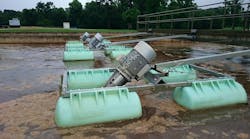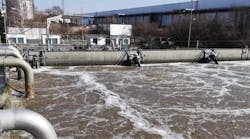Salt. Today, some view it as the industry’s dirty, four-letter word. Used for decades in water treatment, the Water Quality Association (WQA), in its Glossary of Terms, defines salt in the following ways: (chemistry) A chemical compound formed by the neutralization of an acid with a base; (water treatment) sodium chloride (NaCl) or potassium chloride (KCl), both of which are used in solution form to regenerate cation exchange water softeners and some dealkalizers.
While salt in water treatment equipment, especially in softening equipment, has been widely used successfully over the decades, policy makers and environmentalists have been taking a closer examination of its need in certain areas of the country, including California and, more recently, Arizona. Professional water treatment dealers as well as customers have experienced issues related to salt in equipment, such as salt bridging in dry storage brine tanks, which are mostly based on performance and maintenance.
We spoke with a few in the industry who are noticing a shift in technologies and acceptance for newer innovations in the field that are providing some of the benefits of soft water without the concerns of high salt levels being released into the environment.
Where the attention is focused
Recent attention and subsequent bans and restrictions are more focused on the brine discharge from water softening equipment, especially during regeneration. According to WQA, sodium chloride brine saturation in an ion exchange softening brine tank is about 26 percent NaCl by weight at 60º F.
In 2009 when Assembly Bill 1366 (AB1366) in California was put into effect, districts were given the opportunity to prohibit or limit the use of water softening equipment, pushing the issue to the forefront in many states across the nation. However, similar initiatives in the states of Texas, Massachusetts, Michigan and Connecticut, as well as others, continue to gain traction.
Still, some believe the public, especially in non-affected states, are minimizing the issue. Justin Barker, vice president of business development for Pelican Water Systems, says customers need to look at the bigger picture of this controversy to understand the concerns to our environment.
“It’s been glossed over — a few gallons here of water wasted or a little bit of salt that’s entered the sewer system. [But,] somewhere in the average of 5,000 or more gallons [of water] is being wasted a year per family that has a salt-based water softener. And, that is heavily brine-laden water that is going down the drain, which ends up being reconstituted through the water treatment facility and becomes its own very expensive issue to fix. All of this [wasted water and brine discharge] adds up,” Barker says.
An industry’s response
While recent attention, bans and restrictions on water softening equipment have challenged manufacturers and dealers in this industry, many viewed it as an opportunity to assess equipment and make improvements. Mark Bertler, vice president of sales and marketing for HydroNovation Inc. explains advancements that can resonate with environmentally minded customers.
“The technology has gone from simple time clocks, which have served their purpose [for many years], but are not efficient in terms of maximizing the overall efficiency of a water softener,” Bertler notes. “Selecting a DIR, or demand initiated regeneration water softener system allows dealers and their customers to get more use out of traditional water softening technologies and cation exchange [equipment].”
With traditional water softening equipment, the objective today is putting less salt into the environment and reducing the amount of wasted water. For green customers who are interested in traditional ion exchange, experts suggest higher efficiency DIR systems that are more focused on usage and demand.
Educating dealers and customers
In addition to the flaws of traditional methods and systems, user error has also been cited in environmental concerns of water softeners. Particularly with time clock systems, some dealers and customers haphazardly schedule regeneration and two outcomes are usually realized: When regeneration occurs too infrequently, the customer will experience hard water and all of the researched detriments of this water; when set too frequently, waste and brine discharge issues mount.
“Because they want to [limit] service calls, [some dealers] will set the system to clean more often to make sure the customer doesn’t run out of soft water. And, in turn, the system is inefficient and can waste a lot of salt,” asserts Scott Harmon, director of customer satisfaction for Aquion Inc.
Harmon also touts the benefits of DIR systems where a meter is used to accurately estimate the most beneficial time to regenerate the system. Furthermore, adds Harmon, some equipment takes it a step further with the addition of a proportional brining with demand initiated feature.
“With the newer technology of proportional brining, it doesn’t have a set salt amount,” continues Harmon. “[Instead,] it uses the number of gallons used to determine how much salt [is required to clean]. So, unlike most demand systems that have a fixed [amount of salt], a proportional system will salt different every time, making it the most efficient and requiring the least amount of salt.”
Benefits, hold the salt
In addition to improving and adjusting traditional technologies, the industry is also embracing alternative technologies that offer some of the benefits of water softening without the need for salt. Relating it to journey of the auto industry, Bertler is noticing the emergence of the auto industry equivalent of hybrid and electricity-based equipment in the water treatment industry.
Some manufacturers are also offering alternative scale-free or scale reduction equipment , which Bertler concurs with critics that with some of these alternatives it is very hard to demonstrate effectiveness through testing or customer experience. There are however technologies including electro-deionization that one can demonstrate performance with analytical testing. Still, he believes the industry needs to overcome some of its fears when viewing this new equipment.
“[Dealers] remain conservative to some newer technologies,” explains Bertler. “They might feel it is threatening their core business as well as there is a new learning curve. But, there is no silver bullet that will usurp everything that we have [to find solutions for] as an industry. I see these technologies as a way for dealers to support their core business and to deliver more environmentally friendly solutions.”
Bertler adds that the industry has been working hard to meet the challenges discussed in this article. However, he notes that there are limitations with today’s traditional technologies that simply cannot be ignored due to recent research. “If you use cation-based ion exchange, you will generate significant waste water that has chlorides in it and it cannot be easily or cost-effectively repurposed,” he says.
If you have attended a recent WQA Aquatech show or are an avid reader of this publication and its website, you have noticed that more attention is being paid to water treatment equipment that utilizes electricity and hybrid technologies. Experts urge dealers and customers to be educated when buying this equipment because its purpose is not to replace traditional water softening, but rather provide some of the benefits customers have enjoyed for years using water softening equipment.
The industry is adopting more anti-scale and non-regenerating equipment. And, as legislation tightens across the nation and the environmentally minded customer base grows, systems that utilize electricity and hybrid equipment will need to gain acceptance at the end user level.
“One of the biggest hurdles that we have [experienced] regularly is people who are accustomed to water softening, the way the water feels and the product. [These customers] have a difficult time switching to other products, such as anti-scale type products, because the water feels the same [after treatment]. Therefore, someone who has never experienced soft water and what it feels like tends to accept these [alternative] technologies more readily.”
However, one expert believes it is just a matter of time before customers will completely accept these products and he attributes that acceptance to the Internet. Barker asserts that the information on the damaging effects of brine discharge and traditional water softeners is well documented by reputable companies online. According to Barker, WQA and its members should use this resource to educate customers properly.
Barker also adds that “hard water” and “soft water” are marketing terms that are used to help customers understand the technical topic of cation exchange. “In the world of science,” he says, “it is all about scale potential. We need to educate customers and help them understand what water minerals cause scale and affect plumbing and appliances.”
Dealers can use restrictions, bans and pending legislation to inform customers of the issue and then follow through with environmentally preferable options including those outlined in this article. As Harmon concludes, “We have much more efficient water treatment systems than we had 20 years ago. The experts we interviewed for this article say that traditional benefits do not have to come at a cost to the environment.


